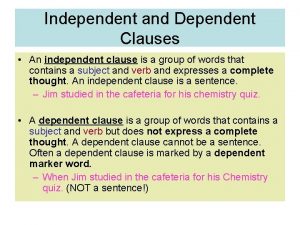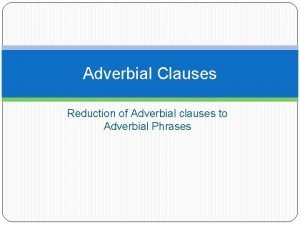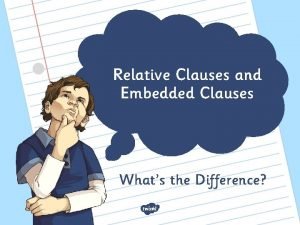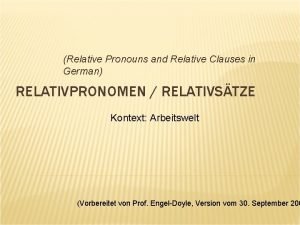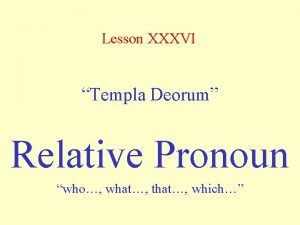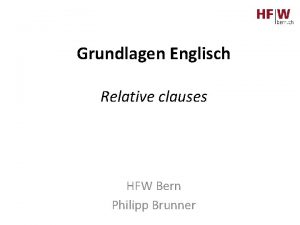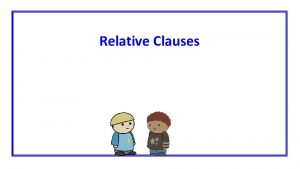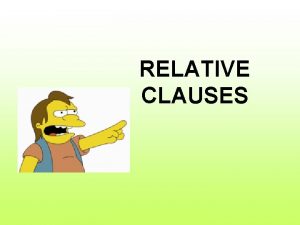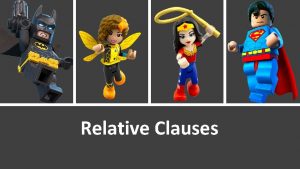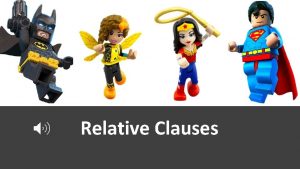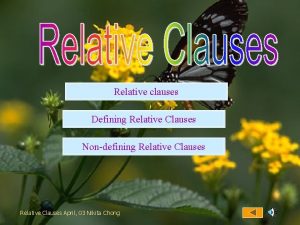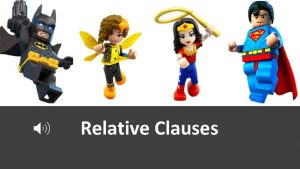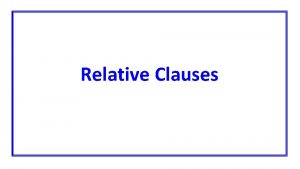Relative Clauses Relative Clauses An Intro A relative











- Slides: 11

Relative Clauses

Relative Clauses: An Intro • A relative clause is a subordinate clause that adds more information to a noun phrase. – A famous one: He who must not be named. – “who must not be named” is the relative clause – Relative pronouns can modify a pronoun, or noun phrase

Relative Clauses – That cat just clawed my face. Do you know who owns that cat? • Do you know who owns the cat that just clawed my face? – Relative clauses help condense sentences. – Relative clauses are usually created by using relative pronouns to connect the two ideas.

Relative Pronoun Use Example who subject or object pronoun for people The old woman who acts crazy on the subway always gets a seat to herself. which subject or object pronoun for animals and things (non-restrictive clauses/restrictive clauses) Unicorns, which are not simply horses with a horn, are beautiful creatures. which referring to a whole sentence My father said, “There’s always money in the banana stand” which was quite literal. whose possession for people animals and things Does anyone know the kid whose father is Darth Vader? whom object pronoun for people, especially in non-defining relative clauses (in defining relative clauses we colloquially prefer who) I was invited on a journey by the doctor whom I met outside a blue police box. that subject or object pronoun for people, animals and things in defining relative clauses (who or which are also possible) (restrictive clauses only) Michael Scott is the kind of boss that I would like to have.

Subject and Object Pronouns – They use the same pronouns but in different ways. – A subject pronoun will be followed by a verb • (example here) – An object pronoun will be followed by a noun or pronoun. • (example) • Object pronouns can be dropped in restrictive relative clauses (example)

Relative Adverbs • Relative adverbs – In cases where a relative pronoun + preposition would be used, a single relative adverb can be used instead.

Relative adverb meaning use example when in/on which refers to a time expression the day when we met him where in/at which refers to a place the place where we met him why for which refers to a reason the reason why we met him

Restrictive vs. Non-Restrictive Relative Clauses. – Restrictive • Also known as Defining/Identifying • Not put in commas • Gives information that defines or identifies the noun phrase – Imagine you’re in a room with 5 different ice cream machines, each with a distinct color but unknown flavor. You might say to your friend: I’m going to eat the ice cream that looks like unicorn poop. – If you just said, “I’m going to eat the ice cream” your friend would not know which flavor you were going to eat.

Restrictive vs. Non-Restrictive Relative Clauses. • Restrictive Clauses con’t: • In restrictive relative clauses, the object pronoun can sometimes be dropped. In the following sentence, the object pronoun “who” is optional: – The evil witch (who/whom) we defeated yesterday liked to turn people into newts.

Restrictive vs. Non-Restrictive Relative Clauses. • Non-Restrictive – Also known as non-defining/non-identifying – Set off by commas – They give extra information that is not necessary to the sentence. • We can flip our previous sentence around: – The evil witch, who liked to turn people into newts, was defeated yesterday. – Here, the relative clause is set off by commas and only provides extra information to the noun phrase. – Note that you cannot drop an object pronoun in a non-restrictive relative clause. (EXAMPLE)

Shortening Relative Clauses • Zero Relative Clauses – As we already discussed, in some cases the relative pronoun may be omitted. • Another method is omitting the relative pronoun when using the –ed or –ing form of a verb. – The train arriving at Platform 9 and ¾ is unknown to muggles. – This is a shortened version of, “The train which is arriving at Platform 9 and ¾ is unknown to muggles. – –ed version: • Rabbits (that were) trained to kill were let loose on the invading army.
 Stage 15 relative clauses and relative pronouns
Stage 15 relative clauses and relative pronouns Relative clauses jeopardy
Relative clauses jeopardy Dependent clauses
Dependent clauses Restrictive clauses and nonrestrictive clauses
Restrictive clauses and nonrestrictive clauses Reduce adverb clause
Reduce adverb clause Embedded relative clause
Embedded relative clause Defining relative clause meaning in telugu
Defining relative clause meaning in telugu Relativpronomen german
Relativpronomen german Relative clauses cvičení
Relative clauses cvičení Underline the relative pronouns
Underline the relative pronouns Coordinadas y subordinadas
Coordinadas y subordinadas Relative clauses englisch
Relative clauses englisch


